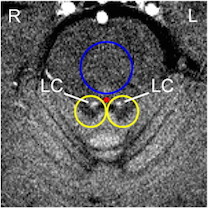The locus coeruleus is a part of the brain that has been getting a lot of attention recently from Emory neuroscience researchers.
The locus coeruleus is the biggest source of the neurotransmitter norepinephrine in the brain. Located deep in the brainstem, it has connections all over the brain, and is thought to be involved in arousal and attention, stress, memory, the sleep-wake cycle and balance.
Researchers interested in neurodegenerative disease want to look at the locus coeruleus because it may be one of the first structures to degenerate in diseases such as Alzheimer’s and Parkinson’s. In particular, the influential studies of German neuro-anatomist Heiko Braak highlight the locus coeruleus as a key “canary in the coal mine†indicator of neurodegeneration.
That’s why neurologist Dan Huddleston, working with biomedical imaging specialists Xiangchuan Chen and Xiaoping Hu and colleagues at Emory, has been developing a method for estimating the volume of the locus coeruleus by magnetic resonance imaging (MRI). Their procedure uses MRI tuned in such a way to detect the pigment neuromelanin (see panel), which accumulate in both the locus coeruleus and in the substantia nigra.

MRI image of locus coeruleus, provided by Dan Huddleston. In slightly distorted Latin, the name locus coeruleus is supposed to mean “blue spot.” The blue appears because of neuromelanin, a dark pigment polymer formed as a byproduct of the synthesis of dopamine and norepinephrine.
A rationale for the clinical use of drugs that boost norepinephrine, such as atomoxetine, with neurodegenerative diseases is that they could help preserve cells in the locus coeruleus. Atomoxetine was known for its use in children with attention-deficit hyperactivity disorder, but is being tested by Emory investigators in people with mild cognitive impairment.
Norepinephrine has been shown to have anti-inflammatory effects, and Emory’s David Weinshenker and Keqiang Ye have recently published findings that it can protect cultured neurons from the toxic effects of the Alzheimer’s plaque protein beta-amyloid.

